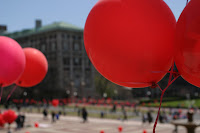
Back when he had Bon Jovi hair,
Andre Agassi used to appear in Canon camera ads and make millions of television viewers cringe by telling them: "Image.... is everything."
It was one of those forgettable pop-culture slogans that you hoped would have the life span of mosquito. But, dammit, there he was, every night for what seemed like years, exposing his God-awful Jersey hair in between innings of a baseball game or in the middle of an episode of the Simpsons. "Image.... is everything," he'd say. "Image is everything." It was like some kind of twisted Bohemian chant that was as intellectually bankrupt as a Lionel Richie song.
"Aaaarrgh!" you'd scream, though not necessarily in public.
Now retired, and bald, we thought we were rid of him and his corny words forever. Gone for good, Andre. A successful tennis career, yes. But that slogan...... somewhere buried in the trash heap of 1980s pop culture history, underneath Lionel Richie, Falco and "Baby-on-Board" signs.
Alas, it's back - the slogan, that is - but only in spirit. For, in our little corner of the world, the mere mention of the word "image" has been, at times, too much to handle.
This week, image
has been everything. It has consumed us. We are reminded of it while we sleep (sleep?) and eat. We telegraph it through telephone calls and emails. We type stories that we're convinced have a connection to "image." But, perhaps, the connection is not quite there. Yet, in our heads is that Agassian chant: "Image... is everything." "Image.... is everything."
The cringe-feeling has returned. But, this time, it's not caused by shame or embarrassment. Rather, it's the creation of tension that's as thick as smog. "Image" is the name of our last homework assignment - and for those of you ready to graduate, it could be your last one ever. And, perhaps, that's caused even more tension.
"Aaaaarrrgh!" you're thinking.
I'm reminded of another 1980s icon:
Jeff Spicoli, the surfer-dude from "Fast Times at Ridgemont High." To me, a guy wearing a flashy red cruise-ship shirt that's hanging wide-open - while he's sitting in a classroom with a pizza on his desk, sassing his teacher - was much cooler than a then-underachieving tennis player wearing a Miami Vice suit jacket and Ray-Ban shades.

Spicoli had a one-word solution for every problem - well, he had other solutions, too - that could prove to be useful advice for every one of us once we discover that Dreamweaver doesn't work, the lips are out-of-sinc with the voices on Final Cut Pro or that Flash upload gets stuck on "12 percent" when we try to call up that web page on Internet Explorer (who made that rule?):
Chill.
Just chill.
The ability to chill is inside us. But it's locked up behind a wall of tension that has stunted our creativity and slowed our potential to imagine "Image."
We are a class of high-achieving, high-I.Q., high-SAT-scoring people. Virtually every one in this class has performed work that is the envy of journalism schools - and perhaps good enough to rival anything produced by the national news media. The "Image" issue is going to kick ass. Face it - you know it. Kenan and Dave are already kicking ass on the designs. You will, too.
Yet, some of the work produced for the "Image" issue shows - at this point, at least - there has been a need for more imagination and confidence and less tension, pain, suffering and feelings of "Aaaargh."
Just chill.
How do you chill?
Back when I used to surf (poorly), we discovered ways of chilling. We didn't think hard. In fact, we never really ever thought hard about anything. But we discovered methods that were simple enough to follow, and effective enough to rival popular solutions produced by intense sessions of psychotherapy:
1. Work hard, yeah, but, you know, have a beer. Have two. OK, if beer's not your thing, have a glass of wine. OK, fine, make it a shot of Jack Daniels. But, please, chill.
2. Watch an episode of "House." Tape it, too, or put it on TiVo, because, with House, you've gotta be quick. Watch it a second time so you can pay close attention to every little obnoxious remark House makes. Once you process each little snide statement, you'll laugh your ass off.
3. While you're at it, watch "Monty Python and the Holy Grail." Yeah, I know. You've seen it 20 times. Get the 25th anniversary edition, however, and watch the outtakes. Before they produced this work of art, they were a mess. But they got through it because, well, there was a lot of chilling going on (at times, they accomplished this through artificial means, but that's not the point).
4. Read that earlier paragraph about "kicking ass." Read it again. Know it. Learn it. Love it.

5. Use the style guide as a rule book, yes. But use it as a guide, too. Remember that each story should have a voice - get to know these voices. Enjoy these voices. Go out for a cup of coffee with the people who produce these voices. If you chill, they'll chill. Then you'll find more voices and, from there, a theme. Then you'll feel the Zen, and you'll find your nut graph that answers the question: What is this story about?
6. If you're stuck, tense, etc., call an editor. I'm at 732-546-1531.
7. If chanting is your thing, as a way of psyching yourself up, forget Andre and consider the words of another American cultural icon, Bill Murray:
"It just doesn't matter."
"It just doesn't matter."
"It just doesn't matter."















































